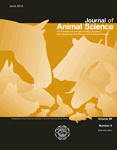-
Views
-
Cite
Cite
L. H. Baumgard, R. P. Rhoads, RUMINANT NUTRITION SYMPOSIUM: Ruminant Production and Metabolic Responses to Heat Stress,, Journal of Animal Science, Volume 90, Issue 6, June 2012, Pages 1855–1865, https://doi.org/10.2527/jas.2011-4675
Close - Share Icon Share
ABSTRACT
Heat stress compromises efficient animal production by marginalizing nutrition, management, and genetic selection efforts to maximize performance endpoints. Modifying farm infrastructure has yielded modest success in mitigating heat stress-related losses, yet poor production during the summer remains arguably the costliest issue facing livestock producers. Reduced output (e.g., milk yield and muscle growth) during heat stress was traditionally thought to result from decreased nutrient intake (i.e., a classic biological response shared by all animals during environmental-induced hyperthermia). Our recent observations have begun to challenge this belief and indicate heat-stressed animals employ novel homeorhetic strategies to direct metabolic and fuel selection priorities independently of nutrient intake or energy balance. Alterations in systemic physiology support a shift in carbohydrate metabolism, evident by increased basal and stimulated circulating insulin concentrations. Perhaps most intriguing given the energetic shortfall of the heat-stressed animal is the apparent lack of basal adipose tissue mobilization coupled with a reduced responsiveness to lipolytic stimuli. Thus, the heat stress response markedly alters postabsorptive carbohydrate, lipid, and protein metabolism independently of reduced feed intake through coordinated changes in fuel supply and utilization by multiple tissues. Interestingly, the systemic, cellular, and molecular changes appear conserved amongst different species and physiological states. Ultimately, these changes result in the reprioritization of fuel selection during heat stress, which appears to be primarily responsible for reduced ruminant animal productivity during the warm summer months.





